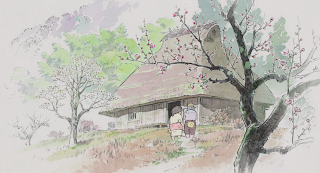The Tale of the Princess Kaguya
The Tale of the Princess Kaguya, directed by Isao Takahata,
is a terrific retelling of the Japanese folktale The Tale of the Bamboo Cutter.
The thematic foundation of the film is the pressure of social assimilation on
individuality and the longing for a real home. These themes were powerfully
reinforced through the film’s eloquent visual narrative.
True Home
 |
 |
 |
 |
 |
The straw house the family initially resided in was featured
prominently in the movie. This was to establish its eventual importance to
Kaguya when she began desiring a simpler life away from the expectations and
pressures of becoming a princess. Despite the lavishness of the new mansion, this
quaint straw house was always home to her. It represented her happiest moments
spent frolicking the woods with her father and among her friends.
Another worth of note are the soft curves present in these
shots. The shape of the house, the hill and the path are all curved. The film
made a point to present these in order to provide contrast to the straight line
heavy architecture of the mansion. Straight lines commonly feel strict and rigid,
which are moods quite fitting to the restrained life Kaguya lived in the
mansion.
Green Cage
 |
 |
 |
 |
An interesting compositional element was associating the
color green with the restriction of Kaguya’s individuality. Green window blinds
were often seen in scenes where Lady Sagami tries to corral Kaguya’s free
spirited personality in order to mold her into a noble princess. In these scenes
she’s taught proper but physically restraining posture and also told to suppress
her emotions. Even when she leaves the mansion she’s metaphorically fenced in since
the color of her carriage is also green.
 |
 |
After her naming ceremony, Kaguya decided to devote herself
to being a lady in order to make her father happy. She has left her playful
personality behind and conformed to the restraints of nobility to acquiesce to
her father’s wishes. The use of green as a color of restriction was at its most
poignant in this moment. Again, notice the heavy presence of green blinds but
this time Kaguya is also dressed in green; the red pattern even matches the red
cords of the blinds. This color trend is followed by the green bird cage with a
red string, which is heavily symbolic of her situation.
_______________________________________________________________________
The shot above was after Kaguya overheard the guests in her
naming ceremony insulting her father. Disgusted by their words, she decided she
had enough and runs home. This one point perspective shot both expresses the
character’s struggle and acts as foreshadowing. The colorful dresses she was
once enamored with were now shackles that she’s shedding. She flees to her home
in the mountains but in this shot she’s also running towards the moon which
foreshadows her unintended escape.
_______________________________________________________________________
 |
 |
In this scene the fourth suitor tries to persuade Kaguya with
sweet words about flowers, devotion and a promise of a modest rural life
together. In the end they were just empty words he has used before to deceive young
women. I really like the use of surface division here. By separating the two in
the frame it prevents conveying any feelings of romance between them but
without leaving Kaguya unaffected. It was important to avoid romance not only
because it would compromise Kaguya’s character but also because the intention of
the scene was to show a young woman so desperate for the happiness she seeks that
she would momentarily cling to the words of man she knows to be deceitful.


Comments
Post a Comment